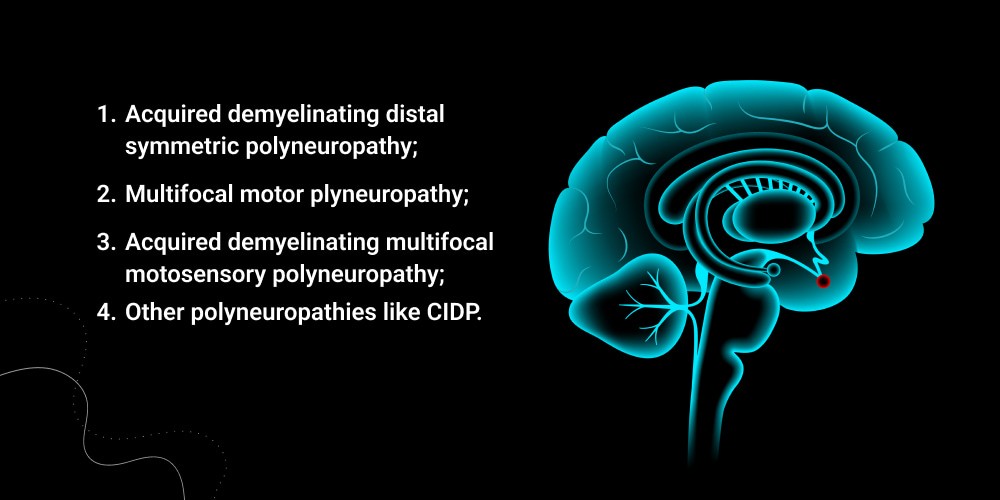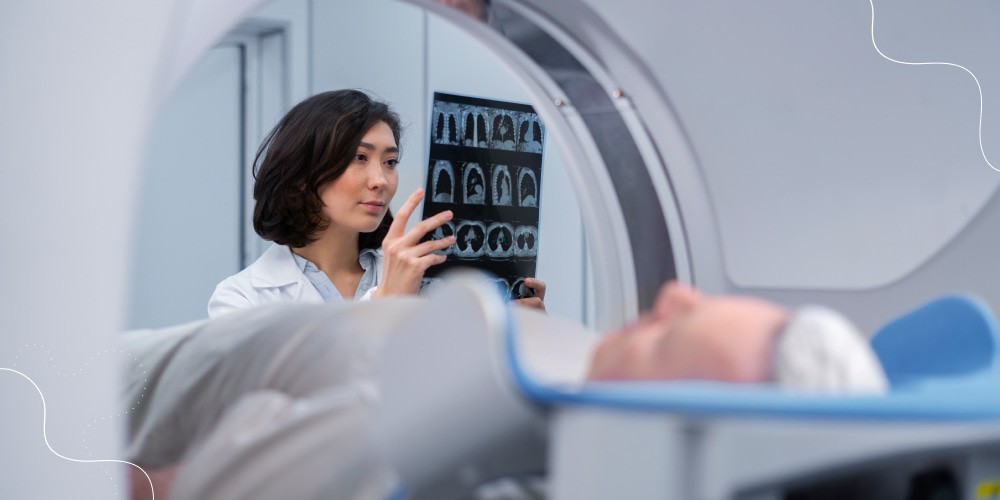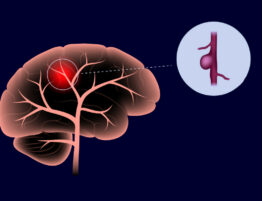Chronic inflammatory demyelinating polyneuropathy (CIDP) is a neurological disorder characterized by inflammation of nerve roots and peripheral nerves.
The main symptoms of this disease are weakness in the arms and legs, unsteadiness when walking, and a feeling of numbness in the hands. This pathology is capable of acquiring an autoimmune character. Researchers note a group of diseases united under one name and were officially recognized only in the 80s of the last century.
CIDP can develop at any age. However, adults most often suffer from it, especially middle-aged men. According to statistics, patients after 50 years of age are more difficult and less responsive to therapy. Demyelinating polyneuropathy occurs in adults 2 cases per 100 thousand population, and pediatric patients 1 per the same number. The disease develops in 2-5% of patients with a concomitant diagnosis. Correct and timely therapy will help you avoid complications. Contact us and make an appointment with our doctors. We have extensive experience in the therapy of neurological diseases.
Clinical similarities with demyelinating polyneuropathy (Guillain-Barré syndrome) and the positive effect of immunosuppressants suggest immune-mediated pathogenesis. Since the first description of cases of chronic polyneuropathy with a response to steroid treatment, the spectrum of clinical symptoms and diagnostic capabilities have expanded significantly, and the same applies to therapy. Differentiation between this condition and other common motor-sensory peripheral nerve lesions accompanying diabetes, alcoholism, or malnutrition remains major.
Causes, Signs and Symptoms of Demyelinating Polyneuropathy
Causes
The causes for the development of CIDP are still not fully understood. However, the results of numerous studies and the effectiveness of immunomodulatory therapy point to a dysfunction of the immune system as a key cause of the development of the disease. In this case, a reaction develops against the components of the peripheral nerve sheath, which manifests itself in the form of specific symptoms characteristic of CIDP.
- Excessive physical and intellectual stress, hormonal imbalance, and stressful conditions are sometimes causative agents. At the initial stage, the pathology has no formation signs. There is no cause for concern in both the patient and the doctor. Diagnosis is impossible in the first few months, but the disease is actively developing.
- The immune system rejects its cells and begins an active fight against them at a certain point. The emergence of circulating immune complexes is observed. There is a process of absorption of the myelin sheath. As a result, the impulse along the peripheral nerve is poorly conducted. A high percentage of diseases are observed due to a genetic predisposition.
Peripheral nerve conduction studies can reveal the main signs of demyelination. Neurophysiological signs typical of pathology:
- partial blockade of motor nerve conduction;
- decreased conduction velocity;
- prolonged latency of distal motor nerves;
- prolonged latency of F-waves.
Dispersion of the distal complex action potential in the muscle fiber is distinguished as a very sensitive diagnostic sign of CIDP. Although research criteria are highly specific, clinical options must be even more sensitive to identify patients requiring therapy.
The main symptoms for the appearance of CIDP:
- Lack of physical strength, energy, and impaired sensitivity in the limbs. This appears along with the impaired motor activity. Fatigue builds up slowly. The duration of the progression of clinical manifestations is from 2 months.
- Deterioration of reflexes to stretch the arms (legs) muscles up to the complete absence of such a reaction. In most cases, weakness appears in the feet, rising slowly. After some time, changes in fine and precise hand movements may be observed. Muscles atrophy much later. Sometimes this symptom does not occur at all. Poor sensitivity of the legs is characterized by instability while walking, and painful sensations.
The classical form of neuropathy is accompanied by a symmetrical lesion, a gradual increase in clinical manifestations, and a positive response to therapy. An atypical appearance can be asymmetric or focal.
Different Forms of Demyelinating Polyneuropathies
Thorough clinical analysis made it possible to identify other forms of the disease with probable autoimmune or dysimmune mechanisms, which differ from CIDP in clinical presentation and in response to therapy. It is not known whether they are subtypes of this condition or whether they are separate clinical units.
- Acquired demyelinating distal symmetric polyneuropathy. It is assumed that a disease is a separate form. Its characteristic features include an increased incidence among men and people over 50, sensory deficit and mild weakness, predominantly in the distal extremities (as opposed to a more generalized lesion in CIDP), and gait instability. IgM paraproteinemia is observed in almost 2/3 of patients with a similar condition. It appears to be poorly responsive to immunosuppressive therapy.
- Multifocal motor polyneuropathy. It is very important to distinguish multifocal motor polyneuropathy from motor neuron diseases. The first is characterized by the presence of asymmetric weakness without a sensitive defect and usually begins with the muscles of the distal extremities. A partial blockade of motor activity in various zones is a characteristic electrophysiological sign, although not in all patients. The same applies to the detection of circulating antiganglioside antibodies. The protein content and the number of cells are usually within the normal range. Even though corticosteroids and plasmapheresis in multifocal motor polyneuropathy are rarely effective, the course of the disease improves with the use of immunoglobulins or cyclophosphamide.
- Acquired demyelinating multifocal motosensory polyneuropathy. It is characterized by several common features with CIDP (motosensory deficiency, increased protein content in the CSF, pathological changes in electrophysiological studies) and multifocal motor polyneuropathy (asymmetry of symptoms starting from the upper extremities, conduction blockade). Some individuals with this condition develop antibodies to gangliosides and respond relatively well to intravenous immunoglobulins and cyclophosphamide.
- Other polyneuropathies like CIDP. Many other variants of acquired and chronic polyneuropathies, similar to this disease, are divided into the following subgroups. It is axonal, isolated sensory, isolated motor, and axonal demyelinating polyneuropathy. Each of them is rarely mentioned in the literature. Basically, it is in patients with peripheral nerves demyelination with a good or at least partial response to immunotherapy that the likelihood of chronic acquired demyelinating polyneuropathy is greatest. Depending on the clinical picture, this diagnosis is possible, probable, or unambiguous. Chronic idiopathic axonal polyneuropathies are a heterogeneous group of slowly progressive neuropathies with or without pain and mild to moderate disability.
Accompanying illnesses CIDP
CIDP can coexist with diseases such as:
- human immunodeficiency viruses;
- hepatitis C;
- Sjogren’s syndrome;
- inflammatory bowel disease;
- Melanoma;
- lymphoma;
- diabetes mellitus;
- monoclonal IgM, IgG, and IgA gammopathy.
The pathogenetic significance of the relationship with the above diseases remains unclear. Moreover, in contrast to acquired demyelinating distal symmetric polyneuropathy with IgM paraproteinemia, the clinical signs of the above conditions with muscle weakness in the proximal and distal extremities are almost identical to those in CIDP and are treated using the same therapeutic approaches.
Of particular interest is the relationship with diabetes mellitus, which has major implications for diagnosis and therapy. Sometimes CIDP can overlap with another hereditary polyneuropathy.
CIDP Diagnosis
Magnetic resonance imaging (MRI) of the brain can detect foci of demyelination in some patients with this disease, despite the rarity of cerebral or cerebellar symptoms in this population.
At the same time, according to the results of one of the studies, demyelination of the visual pathways, as evidenced by the prolonged latency of visual evoked potentials, was observed in half of these patients. In 5–30% of such cases, symptoms of cranial nerve damage are also present. It is interesting to note that the clinical symptoms of cerebral genesis and brain foci according to MRI data in CIDP may disappear after therapy with immunoglobulins.
| Criteria | Diagnostic signs |
| Clinical |
|
| Laboratory | Most experts recommend testing CSF to detect typical signs of CIDP, increased protein content, and normal or slightly increased cytosis. Sometimes there is a need for extended laboratory studies to identify other causes of demyelinating polyneuropathy and associated diseases.
|
The diagnosis of CIDP is considered reliable if all diagnostic criteria are present. A probable diagnosis is considered when all clinical and excluding criteria and 2 or 3 laboratory criteria are present.
Nerve Biopsy
This method is still useful in certain cases. Biopsy of the sural nerve has a higher sensitivity than electrophysiological studies. Pathomorphological changes characteristic of CIDP were observed in 8 of 44 patients, even in the absence of electrophysiological signs of demyelination. It is important to note that 5 patients responded positively to therapy.
The biopsy is especially recommended if CIDP is suspected, in patients with no neural conduction evidence of demyelination, or if vasculitis is likely.
- The diagnostic value of neural biopsy (mainly of the sural nerve) in CIDP has been very intensely debated over the past few years. Some experts do not view it as a diagnostic method, while others consider it a key element of diagnosis and therapy in more than 60% of patients.
- Several researchers have compared signs of demyelination, axonal degeneration, regeneration, and inflammation in biopsies from patients with CIDP and chronic idiopathic axonal polyneuropathy.
- Pathological specimens in most individuals of both groups were characterized by similar changes. In addition, for several reasons, a nerve biopsy is not of high diagnostic value in the above condition. The most pronounced changes are observed in the proximal segments of the motor nerves or spinal roots, which are not always anatomically accessible for this procedure.
Treatment of CIDP
At the moment, there is not a single drug that completely cures polyradiculoneuropathy. However, their complex use reduces the progression of the disease, inhibits the subsequent deterioration or exacerbation, and reduces the severity of symptoms.
In general, treating CIDPe is aimed at:
- blocking pathoimmune processes;
- suppressing inflammation and demyelination;
- and preventing secondary axonal degeneration.
Approximately 80% of people with CIDP report a result in which the general condition becomes weaker. Taking into account the research carried out in the field of treatment of pathology, the intake of the following drugs is distinguished by a high effect:
- plasmapheresis;
- corticosteroids
- immunoglobulins for intravenous administration;
- glucocorticoids.
Along with the intake of these drugs, blood is taken, purified, and returned to it or some part of it back into the bloodstream.
In patients who have responded to it, therapy should be continued until maximum improvement and stabilization are achieved; therefore, there is a need for supportive treatment, which should be selected individually for each patient to prevent, reduce the frequency of exacerbations and slow down the progression of the disease.
A positive therapeutic response is a measurable improvement in motor skills and sensitivity and the patient’s ability to perform daily activities. It is important to remember that infections and febrile conditions also affect the risk of demyelination and can worsen the symptoms of CIDP. The simultaneous administration of neurotoxic drugs or systemic diseases accompanied by polyneuropathies theoretically also affects the symptomatology.
Prognosis of CIDP
This pathology is rather heterogeneous both in terms of clinical manifestations and immunopathogenesis. Further research should facilitate an understanding of its underlying mechanisms, which will lead to the development of more effective treatments.
- Therapy should be initiated at the earliest demyelinating polyneuropathy to prevent progressive demyelination and secondary destruction of axons, i.e., processes leading to disability. According to published data, all three of the above approaches appear to be equally effective.
- The choice of method depends on cost, availability, and adverse reactions (especially for severe persistent side effects of corticosteroids).
- Approximately 60–80% of patients with classical CIDP improve with one of the listed approaches in monotherapy. Still, the long-term prognosis, in this case, depends on the timing of treatment initiation and the degree of axonal damage. Azathioprine, cyclophosphamide, and cyclosporine have long been used as second-line agents for this disease, but precise data on their effectiveness based on the results of randomized controlled trials are not available. For unknown reasons, the benefits of these drugs are not so impressive in polyneuropathy with the production of antibodies to myelin-linked glycoprotein.
If you suspect the symptoms of CIDP, you should see a doctor. Contact us to avoid complications. We provide our services in different cities in Texas, including Dallas, Fort Worth, McKinney, Allen, and others.
FAQ
- How common is CIDP?
CIDP is a fairly rare disease. The average prevalence of patients with CIDP in the world averages up to 0.81-1.90 cases per 100,000 people. Men get sick more often than women. CIDP can start at any age, even in childhood. However, the peak incidence occurs at an average 40-50 years.
- What are the reasons for the development of CIDP?
The reasons for the development of CIDP are still not fully understood. However, the results of numerous studies and the effectiveness of immunomodulatory therapy point to a dysfunction of the immune system as a key cause of the development of the disease. In this case, a reaction develops against the components of the peripheral nerve sheath, which manifests itself in the form of specific symptoms characteristic of CIDP.
- What are the risk factors for CIDP?
As trigger factors, respiratory viral diseases, surgical interventions, pregnancy, vaccination, and other reasons are described. However, a direct connection between the above factors and the development of the disease has not yet been proven.
- How is CIDP manifested?
CIDP is a disease of the peripheral nerves. The exact mechanism of CIDP is not fully understood due to the complexity of responses, and therefore the symptoms and nature of the course of the disease may vary. Hence, the so-called atypical forms of CIDP are distinguished, which differ somewhat from the classical course of the disease and may have features of prognosis and treatment.
- Do I need to make any changes to the usual way of life with CIDP?
Yes. There are several recommendations for patients diagnosed with CIDP:
- avoid any viral and bacterial infections (respiratory viral, enteroviral diseases, etc.);
- move more, in the case of severe movement disorders, physical rehabilitation, ergotherapy, or support means for walking, orthoses, etc .;
- limit smoking, alcohol consumption, which harms blood circulation, aggravating the course of polyneuropathy;
- exclude the use of neurotoxic drugs that aggravate the course of polyneuropathy;
- taking good care of your feet is very important, especially if you have concomitant diabetes mellitus. It is necessary to inspect the feet daily for cuts, calluses, ulcers;
- eating a low-fat diet rich in grains, fruits, and vegetables
- avoid prolonged compression of the limbs.
- Which disease can cause weakness in the arms and legs and a feeling of numbness?
CIDP can have similar symptoms, but to be sure, you should make an appointment with your doctor. The doctor will conduct the necessary analysis and, on their basis, make a diagnosis and prescribe treatment.






 (4 votes, average: 4.00 out of 5)
(4 votes, average: 4.00 out of 5)







Please, leave your review
1 Comment
Harvey Trupkin
22/03/2024
Long time suffer. Treatment has been ivig For the past 12
Write a comment: